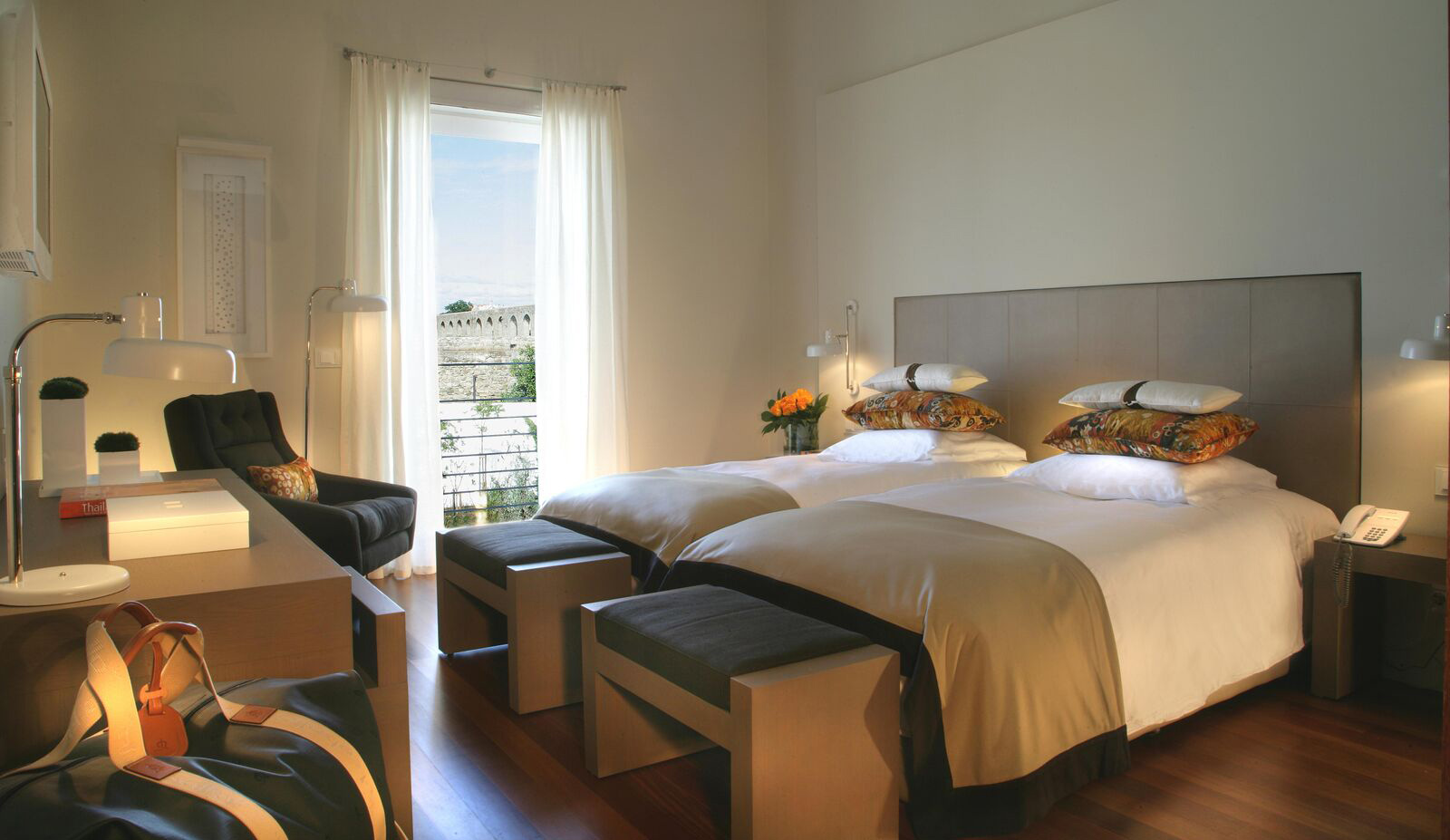What to Expect Staying
in a European Hotel

Checking Into a European Hotel
Upon arriving at your hotel in Europe, the first thing you’ll want to do is freshen up, relax, and unwind before heading out. Entering your hotel room, you may find yourself surprised by the small size, the difference in beds, or how bathrooms are situated. There are some essential differences between American and European hotel rooms, how they’re laid out, and what they offer, but don’t worry. Overall, while the experience is different, there’s a certain charm to European hotel rooms that you’ll miss when you return home!
European Hotel Elevators
European elevators are tiny. That’s because they were built when elevators just weren’t that big, or because the building was retrofitted to accommodate elevators. Smaller elevators are less likely to have issues because they aren’t carrying 3,000 pounds like elevators in the U.S. Generally, about five people will fit in a lift. If you get claustrophobic, stretch your legs by taking stairs. Rest easy, and relax as you head up to your room or down for a tour. Don't forget though, in the U.S., the first floor of a hotel is the lobby. In Europe, the “first floor” is the first floor of rooms.
European Hotel Rooms
Room Sizes in European Hotels
Entering your hotel room, you may be surprised by the small size, the difference in beds, or how bathrooms are situated. Hotels in Europe are several decades or centuries old; some are archaic structures converted into hotels. They’ll have outstanding amenities and charm, but space isn’t an attribute you’ll find plentiful here. Remodeled buildings have all the trappings of modern hotels. European hotel owners are aware of what Americans like, and many have enlarged their rooms, or used creative flair to make the most of smaller rooms.

Beds in European Hotels
Most European hotels advertise rooms featuring double beds. Don’t be surprised to find this doesn’t mean what you think. European hotel beds are one or two twin beds, depending on what was booked for you. Twin beds are separated by a nightstand, but if you prefer to sleep together, move the nightstand and squeeze the beds together. If moving furniture around is something you’re not interested in, let your travel agent know so they can connect with the right resources to ensure you get a full-sized bed.
European Hotel Bathrooms
European hotel bathrooms are often beautifully designed, featuring luxurious materials like marble, high-quality tiles, and elegant fixtures that exude sophistication and style. These refined elements create a sense of luxury and attention to detail that isn't always as common in American hotels, where practicality often takes precedence over aesthetics. However, it's important to note that European bathrooms tend to be more compact, with efficient use of space being a hallmark of their design. While you may come across larger, more spacious bathrooms in upscale hotels or newer properties, many traditional European bathrooms are smaller, especially in older buildings where space is at a premium. Despite the size, European bathrooms often make up for it with sleek designs, modern amenities, and high-end materials that add a sense of charm and elegance.
Hot & Cold Water
Confused by knobs to get the water temperature right? European shower knobs almost always go left for hot water, right for cold. If your shower doesn’t show red for hot and blue for cold, it will show letters. In Spain, you’ll notice “C” for “Caliente,” and “F” for “Frio.” If you’re confused by knobs, the hotel staff is always ready to help at any hour. Before calling the concierge, try swiveling the knob(s) to get desired results for your shower.
The Shower
Americans are used to high water pressure showerheads. Water pressure is lower in Europe, and because hotels are eco-friendly, you may also find hot water doesn’t last as long as it does at home—between 5–10 minutes in European hotels. The best plan is to have all your shower gear set up, ready to go before turning the water on. If someone else needs to shower after you, waiting a few minutes will replenish hot water.
Sometimes, European showerheads won’t engage unless you flip a switch, which is disguised as an everyday switch for outlets. Oftentimes, this switch—which electronically controls the temperature and time the shower will run—is located outside the bathroom. The switch may be accompanied by dials to control water temperature. While this system sounds difficult, upon seeing it, you’ll be able to tell how easy it is to use.
The Bidet
In Europe, bidets are just about everywhere. The bidet is a staple of European culture. This handy bathroom installation is usually next to the toilet. The bidet is a great way to keep things fresh; they’re used so much in Europe you’ll have a hard time spotting a bathroom without one. Don’t be scared to try using a bidet: it’s quite the experience, and one you’ll want to check off your bucket list for sure!
Using Towels in a European Hotel Room
In many European hotel rooms, you'll find a heated towel rail or radiator mounted on the bathroom wall. This handy fixture is designed to warm your towels, making them cozy and dry after use. Typically powered by electricity or integrated with the room's heating system, it adds a touch of comfort and luxury, especially during colder months, by ensuring you always have a warm towel ready.
You may have encountered this in American hotels, but European hotels are more likely to practice being environmentally-friendly by not supplying brand new towels every single day, or supplying fewer for use. Reuse towels as much as you can, and when you want more towels, simply inform the hotel staff as the need arises.
Using a Hair Dryer in a European Hotel
Hair dryers are common accessories in hotels. Should you want to bring your own, though, you will need to bring an adapter and voltage converter or make sure it is dual voltage by checking the label for INPUT AC 120V - 240V or a switch that can be set to 125V or 250V. Many devices have this feature, so it's worth checking before you travel. If you need a hair dryer during your trip but can't find one in your hotel room, you can inquire with the hotel staff. Many hotels will be able to provide a hair dryer upon request, either at the front desk or through housekeeping.
Using an Iron in a European Hotel
When traveling through Europe on a guided tour, it’s common for hotel rooms to have an iron available either in the room or upon request at the front desk. However, it's important to note that the type of iron provided may vary depending on the hotel. While some hotels provide basic irons, others may offer steam irons or ironing services. If you prefer to bring your own travel iron, it’s essential to ensure that you have the appropriate adapter and voltage converter to match the electrical standards in Europe. This will help to ensure that your travel iron functions properly and maintains its longevity.
European Electrical Outlets: Bring Newer Devices and Adapters
American appliances run on 110-120 volts at 60 Hz, while European appliances run on 220-230 volts at 50 Hz. Just as with all outlets in Europe, hotel outlets are made for 220V, not American 110V.
As a result, American appliances designed for use in the United States (typically 120 volts at 60 Hz) may not be directly compatible with the higher voltage used in European countries. Plugging a 120-volt appliance into a 220-240-volt outlet without the appropriate voltage converter or transformer can cause damage to the appliance or pose safety risks.
If you plan to bring American appliances like a hair dryer or curler to Europe, you will need to bring a voltage converter or transformer to change the voltage to 220-240 volts from 110 volts. You will also likely need a plug adapter to fit the American-style plug into the European power outlets. All of Europe operates on the same two round-pronged outlets (Type C).
Using Adapters and Converters for Travel
It's important to note that not all appliances are compatible with voltage converters, so it's essential to check the labels or user manuals of your devices before using them with a voltage converter. Some electronic devices, such as laptops, smartphones, and camera chargers, are dual voltage and can support 120V and 220-240V, so they may not require a voltage converter, but a plug adapter will still be necessary. Also, be sure the appliances you plan on bringing are newer. If they’re more than five years old, they won’t work without a converter, even if you have adapters.
To avoid any issues with electrical compatibility during your travels, consider purchasing appliances specifically designed for the voltage used in the region you'll be visiting or use appropriate voltage converters and plug adapters to ensure the safe operation of your American appliances in Europe.
We recommend purchasing an adapter with a voltage converter so you can pack less. And to pick up any necessary adapters or converters for your electronic devices before departing on your guided tour and bringing them with you.
Air Conditioning & European Hotels
Air conditioning is commonly available in European hotels, restaurants, and public spaces, especially in major cities and tourist areas, but it is worth noting that the settings will differ from what you are used to in the USA.
NOTE: When enjoying historic accommodations and sites, prepare for the absence of modern amenities such as air conditioning, especially in more traditional or rural locations. However, you can rest assured knowing that your Travel Director will be available to support you at every stage of your journey, ensuring a smooth and comfortable experience.









